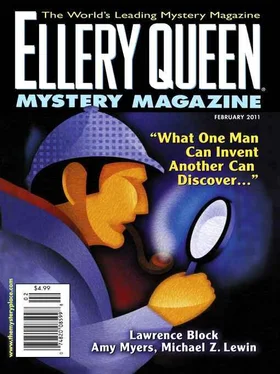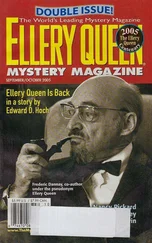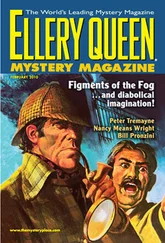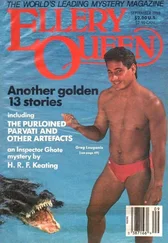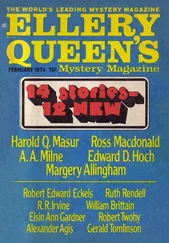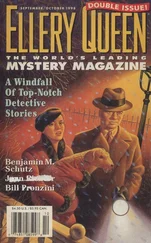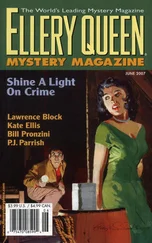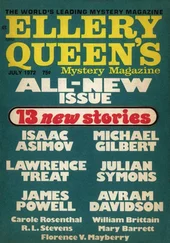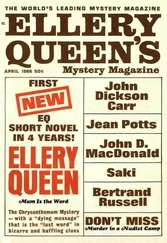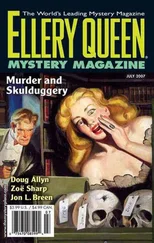Lawrence Block - Ellery Queen’s Mystery Magazine. Vol. 137, No. 2. Whole No. 834, February 2011
Здесь есть возможность читать онлайн «Lawrence Block - Ellery Queen’s Mystery Magazine. Vol. 137, No. 2. Whole No. 834, February 2011» весь текст электронной книги совершенно бесплатно (целиком полную версию без сокращений). В некоторых случаях можно слушать аудио, скачать через торрент в формате fb2 и присутствует краткое содержание. Город: New York, Год выпуска: 2011, ISBN: 2011, Издательство: Dell Magazines, Жанр: Детектив, на английском языке. Описание произведения, (предисловие) а так же отзывы посетителей доступны на портале библиотеки ЛибКат.
- Название:Ellery Queen’s Mystery Magazine. Vol. 137, No. 2. Whole No. 834, February 2011
- Автор:
- Издательство:Dell Magazines
- Жанр:
- Год:2011
- Город:New York
- ISBN:ISSN 0013-6328
- Рейтинг книги:5 / 5. Голосов: 1
-
Избранное:Добавить в избранное
- Отзывы:
-
Ваша оценка:
- 100
- 1
- 2
- 3
- 4
- 5
Ellery Queen’s Mystery Magazine. Vol. 137, No. 2. Whole No. 834, February 2011: краткое содержание, описание и аннотация
Предлагаем к чтению аннотацию, описание, краткое содержание или предисловие (зависит от того, что написал сам автор книги «Ellery Queen’s Mystery Magazine. Vol. 137, No. 2. Whole No. 834, February 2011»). Если вы не нашли необходимую информацию о книге — напишите в комментариях, мы постараемся отыскать её.
Ellery Queen’s Mystery Magazine. Vol. 137, No. 2. Whole No. 834, February 2011 — читать онлайн бесплатно полную книгу (весь текст) целиком
Ниже представлен текст книги, разбитый по страницам. Система сохранения места последней прочитанной страницы, позволяет с удобством читать онлайн бесплатно книгу «Ellery Queen’s Mystery Magazine. Vol. 137, No. 2. Whole No. 834, February 2011», без необходимости каждый раз заново искать на чём Вы остановились. Поставьте закладку, и сможете в любой момент перейти на страницу, на которой закончили чтение.
Интервал:
Закладка:
Ellery Queen’s Mystery Magazine. Vol. 137, No. 2. Whole No. 834, February 2011
Keller in Dallas
by Lawrence Block
One of the hobbies of Lawrence Block’s series character Keller is stamp collecting, which explains why this story first appeared in a philatelic magazine. We thought there were unlikely to be many EQMM readers who’d seen it there, and that the story should be brought to a mystery audience. A couple of years ago, Mr. Block was the keynote speaker at a dinner of the American Philatelic Society, which commemorated the event by issuing a souvenir sheet of four stamps mentioned in Keller stories. (See them at www.lawrenceblock.com).
The young man, who would have looked owlish even without the round eyeglasses, unfolded a piece of paper and laid it on the counter in front of Keller. “The certificate of expertization for Obock J1,” he said. “Signed by Bloch and Mueller.”
He might have been a Red Sox fan invoking Ted Williams, and Keller could understand why. Herbert Bloch and Edwin Mueller were legendary philatelists, and their assertion that this particular stamp was indeed a genuine copy of Obock’s first postage-due stamp, designated J1 in the Scott catalog, was enough to allay all doubt.
Keller examined the stamp, first with his unaided eye, then through the magnifier he took from his breast pocket. There was a photograph of the stamp on the certificate, and he studied that as well, with and without magnification. Bloch and Mueller had sworn to its legitimacy in 1960, so the certificate itself was almost half a century old, and might well be collectible in and of itself.
Still, even experts were sometimes careless, and occasionally mistaken. And now and then someone switched in a ringer for an expertized stamp. So Keller reached for another tool, this one in the inside pocket of his jacket. It was a flat metal oblong, designed to enable the user to compute the number of perforations per inch on the top or side of a stamp. Obock J1 was imperforate, which rendered the question moot, but the perforation gauge doubled as a mini-ruler, marked out in inches along one edge and millimeters along the other, and Keller used it to check the size of the stamp’s overprint.
That overprint, hand-stamped on a postage-due stamp initially issued for the French colonies as a whole, had the name of the place — Obock — in black capitals. On the original stamp, the overprint measured 12 1/2 mm by 3 3/4 mm. On the reprint, a copy of which reposed in Keller’s own collection, each dimension of the overprint was half a millimeter smaller.
And so Keller measured the overprint on this stamp, and found himself in agreement with Mr. Bloch and Mr. Mueller. This was the straight goods, the genuine article. All he had to do to go home with it was outbid any other interested collectors. And he could do that, too, and without straining his budget or dipping into his capital.
But first he’d have to kill somebody.
The Dallas-based firm of Whistler & Welles conducted auctions of collectibles throughout the year. At various times they sold coins, books, autographs, and sports memorabilia, but the partners had started out as stamp dealers, and philatelic holdings remained the largest component of their business. Their annual Spring Equinox sale, held each year in the Hotel Lombardy on the third weekend in March, was one Keller had wanted to attend for years. Something had always prevented him from attending. He’d marked up copies of their catalogs over the years, sent in unsuccessful mail bids on a few occasions, and one year had a hotel room reserved and a flight booked before something or other came up and forced him to cancel.
He’d lived in New York when Whistler & Welles put him on their mailing list. Nowadays he lived in New Orleans, and the name on their mailing list was one he’d borrowed from a local tombstone. He was Nicholas Edwards now, and that was the name on his passport, and on all the cards in his wallet. He lived in a big old house in the Lower Garden District, and he had a wife and a baby daughter, and he was a partner in a construction firm specializing in purchasing and rehabilitating distressed properties.
A year earlier, he’d looked with longing at the Whistler & Welles catalog. Dallas was a lot closer to New Orleans than to New York, but he and Donny Wallings were putting in twelve-hour days and seven-day weeks, just trying to keep up with everything they had going on.
But that was a year ago, before the collapse of the subprime mortgage market and everything that followed on its heels. Credit dried up, houses stopped selling, and they’d gone from more business than they could handle to no business to speak of.
So he could afford the time. A couple of days in Dallas? Sure, why not? He could even take his time and drive to Dallas and back.
And there were plenty of stamps on offer that he’d be eager to add to his collection, with Obock J1 at the very top of his wish list.
Now, though, he couldn’t afford it.
The Lombardy, an independent, locally owned older hotel trying to survive in a world of modern chains, was starting to show its age. The carpet in Keller’s room, while not yet threadbare, was due for replacement. A sofa in the lobby was worn on the arms, and the wood paneling in one of the elevators needed touching up. None of this bothered Keller, who found the hotel’s faded glory somehow reassuring. What better venue for men of a certain age to compete for little pieces of paper that had done their duty carrying the mail long before any of them were born?
Whistler & Welles had booked a large conference room on the mezzanine for their three-day sale, which would begin promptly at nine Friday morning. New Orleans and Dallas were a little over five hundred miles apart, and Keller drove most of the way Wednesday, stopping for the night at a Red Roof Inn at a handy exit from the interstate. He checked into his room at the Lombardy a little after noon, and by one o’clock he was signing Nicholas Edwards on the bidder register and walking over to the long table where they were showing the auction lots.
By two-thirty he’d had a look at all the lots that interested him, and had made cryptic notes in his auction catalog. Every sales lot was illustrated with a color photograph, so he didn’t absolutely have to see them up close and personal, but sometimes you got something that way that you couldn’t get from a photo in a catalog. Some stamps reached out to you while others put you off, and it probably didn’t make any real sense, but the whole hobby was wacky enough to begin with. I mean, spending a fortune on little pieces of colored paper? Picking them up with tongs, putting them in plastic mounts, and securing them in albums? Why, for heaven’s sake?
Keller had long since come to terms with the essential absurdity of the pastime, and didn’t let it bother him. He was a stamp collector, he derived enormous satisfaction from the pursuit, and that was all he needed to know. If you thought about it, just about everything human beings did was pointless and ridiculous. Golf? Skiing? Sex?
Upstairs in his room, Keller reviewed the notes he’d made. There were stamps he’d initially considered and now decided to pass on, others he might buy if the price was right, and a few where he’d be bidding competitively. And there was Obock J1. It was rare, it didn’t come up that often, and this particular specimen was a nice one, with four full margins. Imperforate stamps had to be cut apart, and sometimes a careless clerk snipped off a bit of the stamp in the process. That didn’t keep a letter from reaching its designated recipient, but it made the stamp considerably less desirable to a collector.
Читать дальшеИнтервал:
Закладка:
Похожие книги на «Ellery Queen’s Mystery Magazine. Vol. 137, No. 2. Whole No. 834, February 2011»
Представляем Вашему вниманию похожие книги на «Ellery Queen’s Mystery Magazine. Vol. 137, No. 2. Whole No. 834, February 2011» списком для выбора. Мы отобрали схожую по названию и смыслу литературу в надежде предоставить читателям больше вариантов отыскать новые, интересные, ещё непрочитанные произведения.
Обсуждение, отзывы о книге «Ellery Queen’s Mystery Magazine. Vol. 137, No. 2. Whole No. 834, February 2011» и просто собственные мнения читателей. Оставьте ваши комментарии, напишите, что Вы думаете о произведении, его смысле или главных героях. Укажите что конкретно понравилось, а что нет, и почему Вы так считаете.
